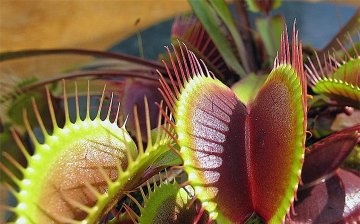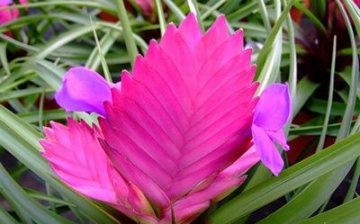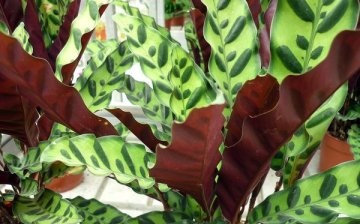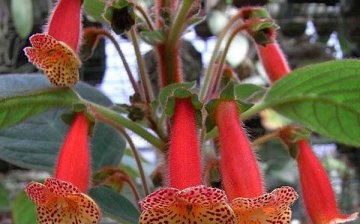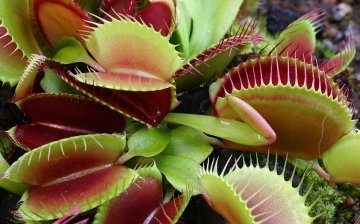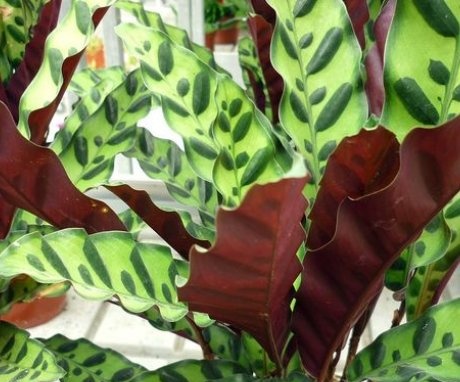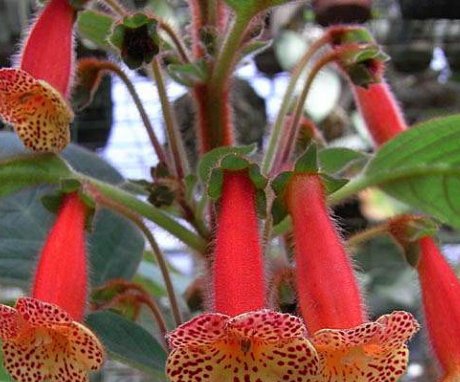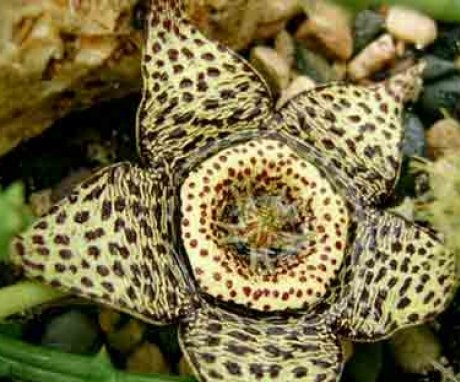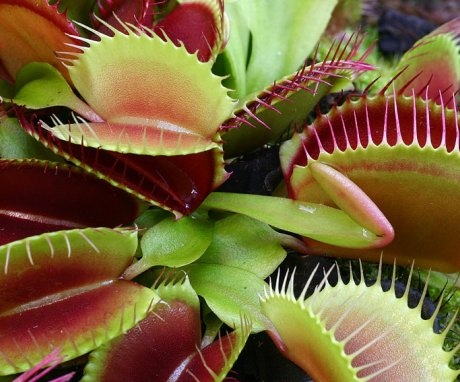The most unusual indoor plants - types and features of growing
Indoor flowers are not only violets, cacti and geranium... At home, you can grow exotic and unusual flowers that will become a real decoration of your home. Recently, the tendency to acquire rare indoor flowers of an unusual type has been gaining momentum more and more in order to surprise guests and enjoy the beauty of amazing plants for themselves.
Content:
Tillandsia blue
This beautiful plant is native to Peru. It looks like an amazing dense pink petal among the green thickets. A small bright blue flower blooms on the side of the pink part of the plant.
Unusual indoor plants like Tillandsia blue can beautify any home.
This flower cannot be called very rare, it can be found in a flower shop, although not in every one. After purchase, you do not need it transplant... The plant reproduces itself. The mother flower sprouts and dies off, while the daughter plant continues to grow. If desired, you can propagate tillandsia and seeds.
To grow this flower, it is advisable to follow a few basic care guidelines. Most likely, the seller will warn you about them when buying a flower. What you need for good growth:
- Tillandsia is used to heat and does not tolerate cold well. The minimum temperature that she can tolerate is 15 degrees. It is desirable that the temperature is about 22 degrees in the room.
- It is not recommended to change the location of the flower. Tillandsia doesn't like that. As soon as you brought a flower from the store, immediately decide on a place. It should be light, but not in direct sunlight. If necessary, in winter the tillandsia can be carefully rearranged to a lighter window.
- Water the tillandsia sparingly, pouring water gently into the middle of the outlet. The soil should be moist, but not floatable. In summer, it is advisable to keep the soil constantly moist, and in winter it can be watered less often, allowing the soil to dry out.
- Feed tillandsia is needed, but not as often as regular houseplants. It is better to choose those dressings that are applied directly to the leaves. During the growth period, you can feed the flower and liquid fertilizer, which is applied to the soil, however, the dosage must be halved compared to that indicated on the package.
- Tillandsias love moisture. The air in the room must be sufficiently humid. In winter, when the heating is turned on, the leaves of the flower should be regularly sprayed with soft boiled water.
- Tillandsia, unfortunately, often suffers from a fungus. It is very easy to overdo it with moisture and watering, which leads to leaf rot. In this case, the room must be ventilated, and all damaged leaves must be removed.
Calathea is wonderful
An incredibly beautiful flower in which everything is remarkable: both leaves and flowers. The leaves of the calathea are very beautiful, elongated, large with a varied pattern. Most often, there are white streaks on dark green leaves, rhombic and zigzag patterns.
It is an interesting houseplant native to South Africa.Calathea is wonderful, the most suitable type of pricks for growing at home, the rest can be quite capricious. This plant is distinguished not only by its unique appearance, but also by the ability to move leaves during the day.
In the evening the leaves rise, and in the morning they fall again, therefore the second name of calathea is "prayer flower".
Growing tips:
- Heat-loving calathea is very fond of light. Therefore, you need to put it in a well-lit place. She herself will make it clear what she needs. If the leaves turn brown, then there is little light, and if they fade, turn pale and lose their former beauty, then there is too much light.
- It is best to grow calathea on the east window. Calathea does not like low temperatures. It is undesirable for the room temperature to fall below 18 degrees. Various drafts, temperature changes and frequent rearrangements can also harm a capricious flower.
- In order for the leaves of the plant to remain bright and beautiful, it is necessary to monitor watering, do not allow the soil to dry out or waterlogging. The air humidity must also be sufficient. Leaves and air around the flower need to be regularly spray.
- You need to fertilize the plant, but not too often. For feeding special fertilizers for ornamental plants. They need to be brought in only after watering.
- If you grow calathea yourself, plant it not in a deep, but in a wide pot, because root system this color is slightly developed.
- Transplant calathea is needed once a year or two. If you plan to reproduce with rhizomes, it is best to let the flower rest for 2 years. When transplanting, you just need to separate a small part of the rhizome and plant it separately. If you cut off too much, the whole plant will die.
If you do not follow all the rules of care, calathea quickly infect scabies. These insects stick to the leaves from the underside and suck the juice out of them. As a result, the flower begins to wither and dry out. Collecting them by hand is almost impossible. The flower must be treated with a special solution.
Coleria fluffy
Unpretentious and very interesting koleria flowers were brought from Mexico. The entire flower from leaves to bud is covered with fluff. The flowers are often red, but there are also pink and orange, covered with fluff, elongated. They are like bells on a long leg.
Small specks can be seen on the petals themselves.
Coleria does not require complex care, but it is necessary to follow some rules so that the plant does not lose its beautiful exotic appearance:
- Like any flower, koleria loves light. In winter, you can freely put the pot on a light windowsill, and in summer it is advisable to cover the flower with a transparent cloth so that the hot sun does not dry out and burn the delicate flowers.
- Coleria loves warmth. A temperature of 25-26 degrees will be comfortable for the flower. In winter, it can tolerate a cold of at least +16.
- You rarely need to water the color. In winter watering becomes even rarer. It is enough to make sure that the earth does not dry out or crack. It is advisable to water through a tray or from above, but carefully so that water does not get on the leaves. The water should be soft and not cold.
- Humidity is not too important for this flower, but it grows more slowly in dry air. Spray in no case is it possible. To increase the humidity, a tray of water will be enough.
- In the summer, koleria is fertilized every week with special top dressing for decorative flowering plants. The rest of the time, feeding is not necessary.
- Bloom lasts approximately 3-4 months and lasts from mid-summer to mid-autumn. Then comes a period of rest. During this time, the plant can be pruned slightly to strengthen the root system, and occasionally watered to keep the soil from drying out. At rest, the flower should be placed in a cooler place.
- You can multiply the color as seedslike cuttings... The seeds are sown at the end of winter. You do not need to sprinkle them with earth. It is enough to water and cover with foil or glass. The container with the seeds is kept warm and aired daily, otherwise the seeds will mate and begin to rot. When the sprouts become larger, they are planted. When propagating by cuttings, the upper part of the shoot is cut off and planted in a container with damp earth, covered with glass and placed in a warm place.
Stapelia variegated
This flower is very popular due to its unusual flowers and unpretentious care. However, keeping them in the bedroom is not recommended. These flowers give off a very unpleasant rotting smell. You can admire them, but not sniff. The stems resemble a cactus, but in reality they are ordinary stems with small and not sharp teeth.
The slipway has no leaves, but it has unusual flowers that resemble a starfish. In the variegated staple, the flowers have specks all over the surface.
Plant Growing Tips:
- In summer, a comfortable temperature for a flower will be 26 degrees. In winter, you can arrange a small rest for the plant by placing it in a cooler room, but with a temperature of at least 15 degrees.
- For a flower to bloom, it needs light. In the shade, the stems stretch out, but the buds are never formed. However, on hot days, it is best to store the flower in a more sheltered location so that the flowers do not get burned.
- Stapelia does not require frequent glaze or constant moisture. It is necessary to ensure that the soil does not dry out, and this is enough. If there is too much moisture, fungal diseases... When planting and transplanting, drainage must be placed on the bottom of the pot. You need to water the plant once a week, and in January and February, when the dormant period begins, you can not water at all.
- You need to feed the stocks only in the summer and no more than twice a month. To do this, you need to buy a special fertilizer for cacti and succulent plants.
- Stapels grow very quickly, so their transplanted every year in a larger pot. If the plant is already an adult, when transplanting from the middle, you need to remove those shoots that no longer bloom. A newly transplanted plant does not need to be watered immediately. It is left without watering for several days.
It is difficult to miss the bloom of the stocks; it immediately begins to exude its characteristic fetid odor. This can be explained by the fact that the flower is pollinated with the help of carrion flies and this scent attracts insects.
To prevent the smell from spreading through the apartment, during flowering, the slipway can be taken out onto the balcony and admired through the glass.
If the stapelia is sick, it is from improper care. If you do not overdo it with moisture, the flower will not hurt. If a plant infects a spider mite, you can get rid of it with the help of special drugs.
Venus flytrap
An amazing and at the same time frightening exotic indoor flower, whose buds are very reminiscent of small green jaws. It is an insectivorous plant.
It is not difficult to grow it at home, and its unusual appearance will not leave indifferent any guest.
To grow a Venus flytrap, you need to follow the following care rules:
- This plant does not like lime and any fertilizers, so it is not recommended to add them to the soil. The soil should be composed of sand and sphagnum moss.
- Venus flytrap does not grow well in the shade. It is necessary to provide it with a sufficient amount of scattered light for at least 4 hours a day. But you must not allow direct sunlight to hit it, they leave burns. With a lack of light, the flower turns pale, and its leaves stretch out.
- Do not water the flower with tap water. They are too tough. For watering, you can use boiled or filtered water.
- Humidity of air and soil should be sufficient, but not excessive. Drainage will not interfere with transplant.
- Venus flytrap does not need additional insect feeding.Under normal watering and lighting, it will grow without any additional top dressing... However, if you wish, you can feed the flower, but not overdo it. It is enough to do this once a week or two.
- You need to choose small insects for feeding so that they are completely placed in the trap. You can feed 1-2 traps at a time and 1 insect per trap. After that, the trap will slam shut and will not open for several days.
- Do not feed the flycatcher if it is weakened. Plants require a tremendous amount of energy to slam a trap. She can die with frequent and untimely feeding.
- Plant propagates seeds... In the spring, beautiful white flowers appear, which then give seeds. You can plant seeds 3 months after harvesting.
Despite its predatory appearance, the Venus flytrap will quickly become the favorite of the grower. Due to its peculiar nutrition, it creates the impression of a very real living creature that needs care and feeding.
More information can be found in the video.



